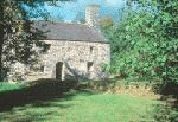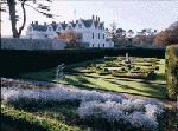The
Museum of Welsh Life

One of our
excursion highlights was the trip to the Museum of Welsh Life on Thursday,
17 June. As it was not part of the official programme, the students could
choose freely whether to join or not. But as we found out, the trip was
really worth it. The museum is situated at St. Fagans in the environment
of Cardiff, so our way there did not take too much time. We left at 2
pm from the University accommodations and arrived at the museum at approximately
2.30. The weather was fine that afternoon which was important because
most parts of the Museum of Welsh Life are open air. It comprises an area
of 100 acres. There are Welsh buildings from various parts of Wales and
different historical eras. The visitor has the opportunity to walk into
these houses and get an impression about how Welsh life has developed
during the past centuries. The buildings are fully furnished with the
artefacts and furniture appropriate to the times. In each of them there
were friendly attendants who were ready to give us explanations about
the use of the artefacts and the daily life of Welsh people in history.

In
most buildings Welsh life of the 19th and early 20th centuries is reflected
but there are also farmhouses and cottages of earlier eras. Among those
there are two outstanding buildings: St Fagans Castle which is a late
16th century manor house and St. Teilo’s – a 13th century
church. In this medieval house of God there are wall paintings showing
scenes from the Bible. Most people could not read and church services
were only held in Latin. That is why these paintings were very purposeful
during that time.
At the exit of the museum there is a souvenir shop in which the visitor
can buy typical objects of Welsh life in history. Many students of our
group seized that opportunity. After spending three hours in this informative
museum which is well-known all over Wales we went back to the university
accommodations by coach. Even a whole day in the museum would certainly
not have been boring because of the wealth of exhibits to explore. But
the three hours we were there were also sufficient to gain a general idea
of Welsh life in history.
Hanno
Heuel
|
